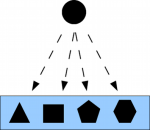Chomsky’s mechanism (and embryonic development) are significantly different from the selectionist mechanisms of biological evolution or the immune system. Surprisingly, there is a very abstract way using two dual mathematical logics to make the distinction between genuinely selectionist mechanisms and what are better called “generative” mechanisms. This note outlines that distinction.
Partitions and Objective Indefiniteness in Quantum Mechanics
The problem of interpreting quantum mechanics (QM) is essentially the problem of making sense out of an objectively indefinite reality–that is described mathematically by partitions. Our sense-making strategy is implemented by developing the mathematics of partitions at the connected conceptual levels of sets and vector spaces. Set concepts are transported to (complex) vector spaces to yield the mathematical machinery of full QM, and the complex vector space concepts of full QM are transported to the set-like vector spaces over ℤ₂ to yield the rather fulsome pedagogical model of quantum mechanics over sets or QM/sets.
Introduction to Logical Entropy
This paper, a reprint from the International Journal of Semantic Computing, introduces the logical notion of entropy based on the newly developed logic of partitions that is mathematically dual to the usual Boolean logic of subsets (aka “propositional logic”), and compares it to the usual Shannon entropy.
Quantum mechanics over sets
This paper gives a toy model of quantum mechanics over the field 2, where the vectors can be interpreted as subsets of a universe set, and hence the name: “Quantum mechanics over sets.” It gives the “logic” of QM in the old-fashioned sense of the essential logic of a theory pared down to operations on sets (vectors over 2). This includes the simplest logical treatment of the double-slit experiment, Bell’s Theorem, the probability calculus based on Born’s Rule, and much else (all restated in the context of sets).
Information as distinctions
This paper is sub-titled “New Foundations for Information Theory” since it is based on the logical notion of entropy from the logic of partitions. The basic logical idea is that of “distinctions.” Logical entropy is normalized counting measure of the set of distinctions of a partition, and Shannon entropy is the number of binary partitions needed, on average, to make the same distinctions of the partition.
The Objective Indefiniteness Interpretation of Quantum Mechanics
The purpose of this blog entry is to briefly describe a new interpretation of quantum mechanics (QM). A long paper introducing this objective indefiniteness interpretation is available at the Quantum Physics ArXiv and (a more recent version) on my website.
History of the Logical Entropy Formula
The logical entropy formula Given a partition on a finite universe set U, the set of distinctions or dits is the set of ordered pairs of elements in distinct blocks of the partition. The logical entropy of the partition is the normalized cardinality of the dit set: . The logical entropy can be interpreted probabilistically […]
From Partition Logic to Information Theory
A new logic of partitions has been developed that is dual to ordinary logic when the latter is interpreted as the logic of subsets rather than the logic of propositions. For a finite universe, the logic of subsets gave rise to finite probability theory by assigning to each subset its relative cardinality as a Laplacian probability. The analogous development for the dual logic of partitions gives rise to a notion of logical entropy that is related in a precise manner to Claude Shannon’s entropy.
Series-Parallel Duality: Part II: Financial arithmetic
In financial arithmetic and in the appraisal literature, it has been noticed that the basic formulas occur in pairs, one being the reciprocal of the other. This Part II of the series-parallel duality post shows that these reciprocal formulas are an example of the SP duality normally associated with electrical circuit theory.





